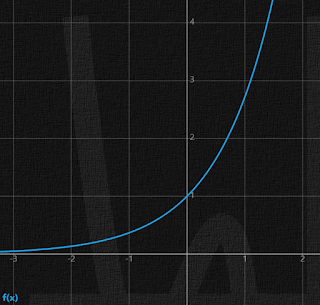Introduction
I have promised for the last couple blog posts that I would talk about the math behind some gospel relationships found in the scriptures. For those of you who have been anxiously awaiting the fulfillment of this promise, you're in luck; that's what this post is all about. However, I will first share a little background on this discovery.
One morning, I was studying the topic of knowledge and intelligence. I noticed an interesting pattern: the scriptures teach that if we increase our knowledge and intelligence, we will be able to continue to increase them at a faster rate. This can be compared to financial investment: the more money you currently have, the quicker you can gain more money.
Those of you who know me really well know that my two favorite things are the Gospel of Christ and math. Seeing a scriptural example of quantities changing in a specific way allowed me to recognize that my two favorite things can be combined. This was the birth of theometry. Within a few minutes, I was coming up with equations to model increases in knowledge and intelligence. Within a few more minutes, I was drawing graphs of the equations and showing them to my missionary companion. (I had been on a proselyting mission for the LDS Church for about six months at the time.) I was ecstatic.
Before long, I had come up with equations for knowledge and intelligence, faith and works, agency, diligence, et cetera. As I began to see the implications of these equations, the words of an ancient prophet named Alma kept coming to my mind. (I will explain why later in this blog post.)
By Small and Simple Things
Near the end of his mortal ministry, the great prophet Alma gathered together his sons Helaman, Shiblon, and Corianton to give them words of counsel. He spoke to Helaman first, and told him that he was going to entrust the spiritual and historical records of the Nephites and Jaredites into his hands. During Alma's explanation to his son of the great importance of these records, Alma said:
"behold I say unto you, that by small and simple things are great things brought to pass; and small means in many instances doth confound the wise. And the Lord God doth work by means to bring about his great and eternal purposes; and by very small means the Lord doth confound the wise and bringeth about the salvation of many souls."Alma's words were surely fulfilled. Some of the recorded material given to Helaman later became part of what we know today as "The Book of Mormon: Another Testament of Jesus Christ". This is a book of sacred scripture that members of the Church of Jesus Christ of Latter-day Saints (commonly referred to as "Mormons") read alongside the Holy Bible. From this book, millions of people around the world have gained a testimony of the gospel of Jesus Christ and a knowledge that God still speaks to His children today through a living prophet. This small and simple book has confounded the wise and brought about the salvation of many souls.
 |
| Through small and simple miracles, records of ancient prophets were preserved and became the Book of Mormon. |
The doctrine that God brings about immense results through very small means is applicable to so many aspects of Christ's gospel. I have gained a testimony of this as I have involved myself with theometry. The rest of this blog post will show a few gospel relationships that teach the impact of small and simple numbers. If you don't want to learn all the math involved, you can still learn from what I will share by reading the rest of the text and looking at the graphs.
Knowledge and Intelligence
Since I have already talked a little bit about knowledge and intelligence, we will investigate this gospel relationship first. We can easily learn how these two attributes are related by looking in a dictionary. The Google dictionary defines intelligence as "the ability to acquire and apply knowledge and skills." In other words, the greater your intelligence, the faster you can learn.
Intelligence = Rate at which you can increase your knowledge
We can learn even more about the relation between these attributes by reading the scriptures. Doctrine and Covenants 88:40 teaches:
"For intelligence cleaveth unto intelligence; wisdom receiveth wisdom; truth embraceth truth; virtue loveth virtue; light cleaveth unto light"The more intelligence, wisdom, truth, or light we have, the faster we can improve at these attributes. Since we can gain knowledge faster by having more knowledge, and since intelligence is our ability to acquire knowledge, an increase in knowledge results in an increase in intelligence.
Increase in knowledge = Increase in intelligence
Now it's time for some math. I will represent knowledge with the letter "K", intelligence with the letter "I", amount of effort being put into studying with the letter "S", and time with the letter "t". For notation, I will have "∝" mean "is proportional to", and adding a "d" before a variable will mean "a change in". For example, if I said "dK ∝ 2", that would mean "a change in knowledge proportional to two".
In order for someone to have an increase in knowledge of a certain amount (dK), they need to have some level of intelligence (I), some amount of effort being put into studying (S), and some time to have elapsed (dt). A formula to model this concept is:

I will now use calculus to solve for "I" (It's okay if you don't know calculus. Feel free to skip down to the graph of the function I will derive.) I will assume the rate of study is constant over time and will introduce arbitrary constants (c1, c2, c3, c4, & c5):
Now, since a gain in knowledge yields a gain in intelligence, we can solve for "K"

Shown below is a graph of how knowledge or intelligence might change over time assuming a constant rate of studying:
 |
| Knowledge or Intelligence as a Function of Time |
Why is mathematically modeling knowledge and intelligence useful? For me at least, visually seeing the enormous difference that putting forward the effort to gain knowledge can make is motivational. Seeing this graph helps me better understand my divine nature and scriptures such as Doctrine & Covenants 130:18-19:
"Whatever principle of intelligence we attain unto in this life, it will rise with us in the resurrection. And if a person gains more knowledge and intelligence in this life through his diligence and obedience than another, he will have so much the advantage in the world to come."Increasing doctrinal understanding is crucial because, as Boyd K. Packer taught:
"True doctrine, understood, changes attitudes and behavior (Ensign, "Little Children")."I can bear my testimony that God's hand is found in everything. As we seek for Him in all that we do, He will reveal Himself in ways we may not have expected. Stay tuned for my future blog posts!
"By Small and Simple Numbers" is to be continued.
Check out my other blog that gives Mormon answers for life's great questions at mormonanswersforlife.blogspot.com



Nick wants to know how you can start with a negative amount of knowledge? (On the graph is starts in the negative.)
ReplyDeleteThanks for your comment! That was very observant of Nick.
DeleteEven though the y-axis in the picture shows negative values, if the right constants are chosen for the functions for knowledge or intelligence, negative values will never be obtained. I will probably right more about properly choosing the constants. If so, I will let you know.
I've actually heard that theirs a bunch of research already done out there about studying. A bunch of statistics and graphs about how much knowledge is retained after "x" amount of time studied. Might be fun applying those numbers to this.
ReplyDelete